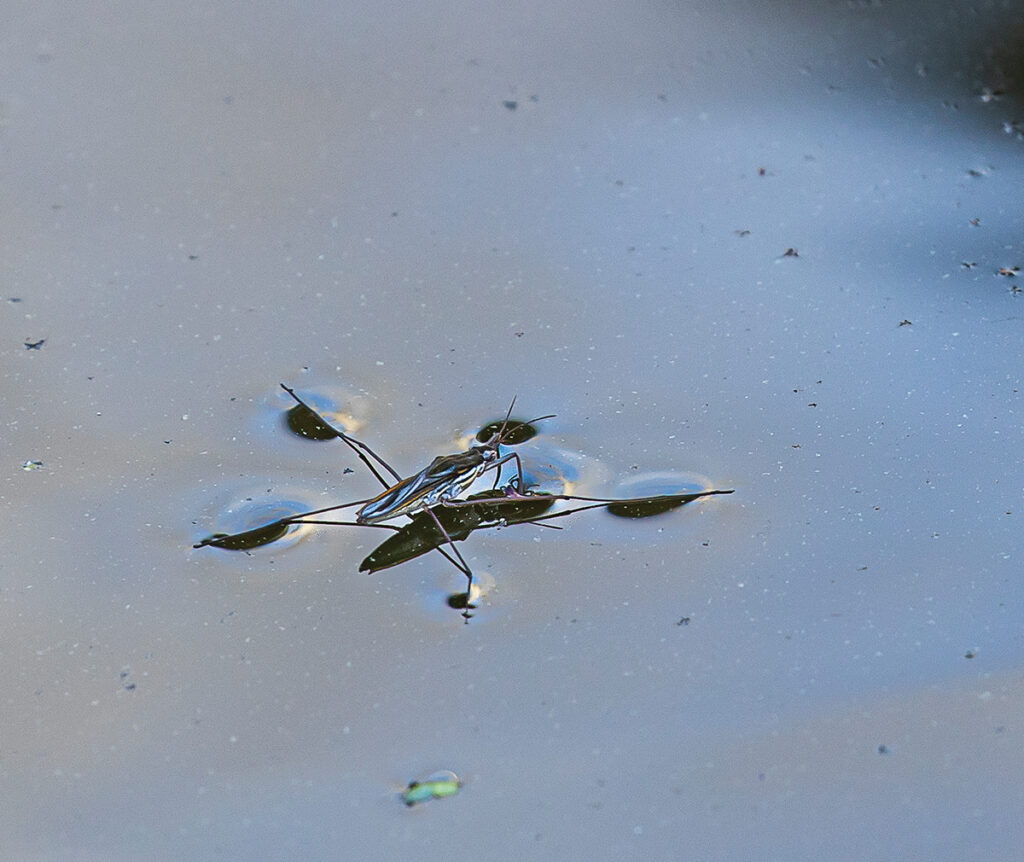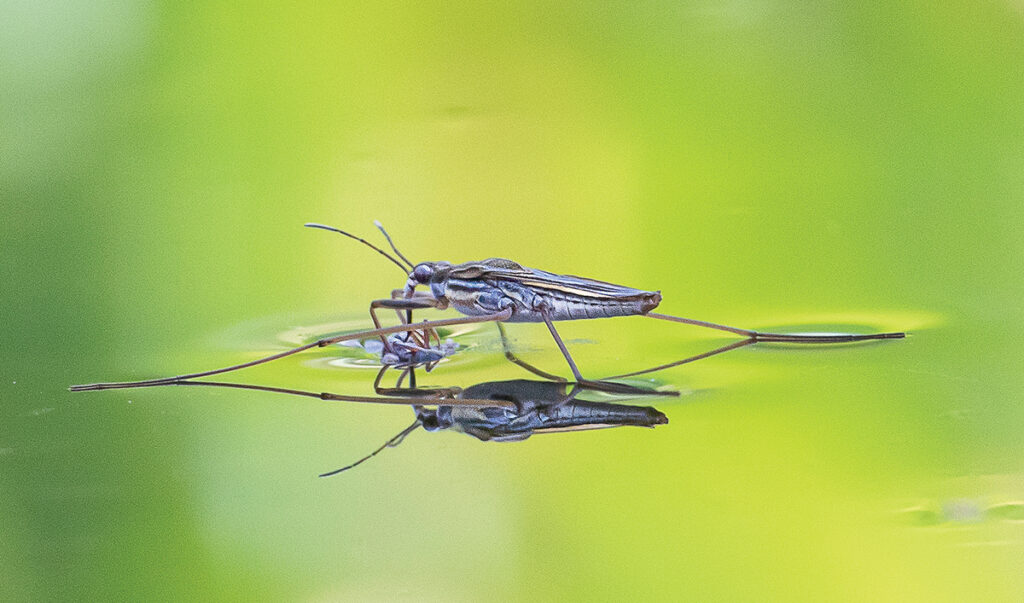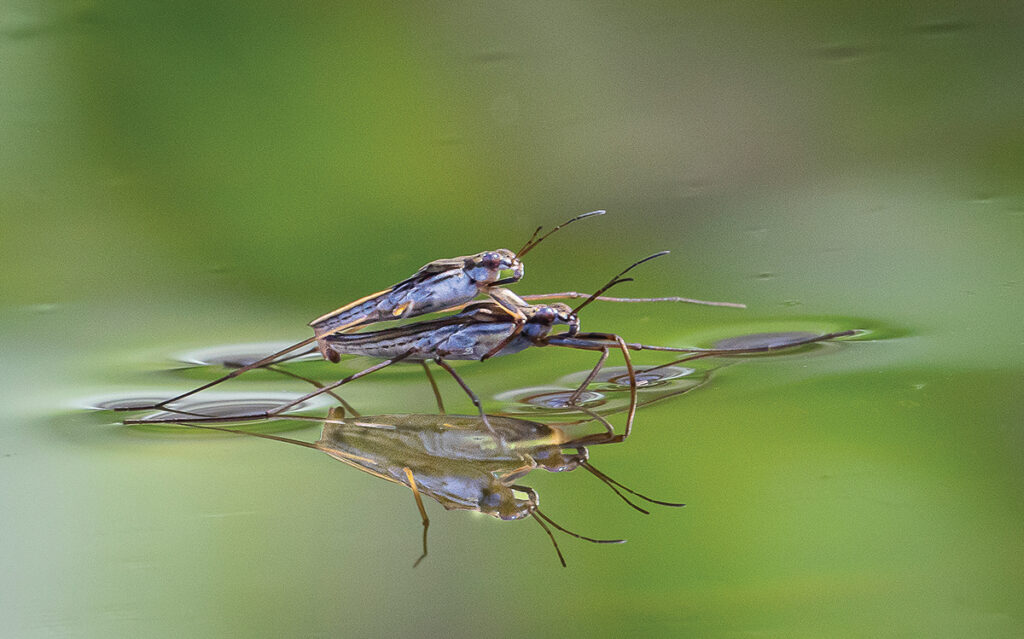A closer look at the floating bugs that glide along the surface of creeks and ponds — and the mysteries surrounding them.
Words and photographs by Mike Dunn

When I was a kid, I spent a lot of time roaming the woods and fields at my Aunt Ruth’s place near Whitetop Mountain, Virginia. My folks usually spent a week “back home” in the mountains every summer, and I relished my time wandering around looking for critters. I would wade into the creek in the woods behind her house, flipping rocks to see what lived under them, building dams to create pools and generally doing things kids do in a creek.
There were a few pools where I could spend time with two of my favorite creek critters, crayfish and water striders. I learned to catch crayfish without getting bitten (usually), and spent a lot of time watching the water striders. I don’t remember trying to catch them with my hands, maybe because I wasn’t quite sure what they were.
It fascinated me that water striders could skate across the surface of the creek. And I still love the dimpled shadows they leave on the stream bottom from where their legs rest on the surface film.
Over the years, I have watched water striders catch prey, I’ve caught them in nets, showed them to teachers and students and become accustomed to seeing them on most streams and still waters in our state. But it wasn’t until we refurbished our two water gardens a couple of years ago that I really started to observe, photograph and learn more about these amazing creatures.
Water striders are insects in the category of true bugs (and you probably thought all insects were true bugs, right?), part of the insect order Hemiptera. Other common true bugs include terrestrial stink bugs, cicadas and leafhoppers and aquatic groups like backswimmers and water scorpions. True bugs have piercing mouth parts that they stick into their food (plants or prey organisms) to suck out fluids.

There are over 1,700 species of water striders worldwide. Most live in fresh water, although there are a few that are marine insects, spending their lives on coastal seas and the open ocean.
Water striders literally walk on water. This has given rise to a lot of colorful common names like Jesus bugs, pond skaters, pond skimmers and water skeeters. Their slender, lightweight bodies are well-designed for this amazing feat. They spread their minimal weight over a large surface area by having two pairs of superlong legs (the third, front pair is much shorter and used for grasping prey).
Unlike most insects that have claws at the tips of their legs (“feet”), a water strider’s claws are located a bit higher up, so that they do not puncture the surface of the water. But the real key to their success is the abundant microhairs that cover many parts of a strider’s body. There are thousands of microscopic grooved hairs covering the legs and undersides of water striders.
The tiny grooves trap air, helping the legs repel water, allowing the insect to push a dimple in the water and take advantage of the surface tension. Scientists are studying these hairs for possible waterrepellent designs for products like rafts, water-based robots and even mini-aquatic spies. (Perhaps they could be called water spy-ders?)
Watch a strider and you will see it uses the front pair of its longer legs as oars. The hind legs help propel it and are used as rudders. The small front legs grab and hold their prey (usually an insect on the surface). They detect their prey by sensing its vibrations on the water. Much of their food consists of small insects that fall into the water and are trapped by the surface tension.
They also feed on other striders (especially young ones) and other invertebrates emerging from underwater, like mosquitos. After grabbing an insect, a water strider will pierce it with its sharp beak and inject digestive enzymes that liquefy its insides. Using a “pump” located inside the strider’s head, it will then suck up the prey’s predigested nutrient milkshake. Yum!
To allay the fears of those of you who like to swim in local ponds and lakes: Water striders are harmless to humans and will not skate over to give you a bite just for fun. One reference claims the mouth parts are too weak to penetrate human skin. (But I’m still not testing that theory by grabbing one in my palm.)
While photographing water striders one afternoon, I saw several mating pairs. Males are generally smaller than females and announce their intentions by tapping the water surface and sending out romantic ripples. Receptive females “come hither” and they pair up, males on top. I also saw several rejections, with females jumping and flipping the males off.
After successful mating, females lay eggs on plant stems or other solid surfaces just under the surface. I have thus far failed to find their eggs to photograph them, but I’ll try again this year (this passes for entertainment in a naturalists’ world). The eggs hatch into tiny nymphs that will molt several times over a few weeks before gaining their adult size.

One other interesting fact about water striders is that within some species they exhibit wing polymorphism: Some have full-sized wings, some have small wings and some no wings at all. It apparently depends somewhat on their habitat. A temporary pool or one that fluctuates greatly will lead to winged individuals that can fly and migrate if the need arises. Those in more stable environments, like large lakes, may not have wings at all.
Even as I’ve learned more about my local water striders, there are still plenty of mysteries. For example, we noticed striders in our newly refurbished ponds the day after we filled them — how do they find new water sources so quickly? Where are those elusive eggs?
What do they do in the winter? (Some resources say they hibernate under debris near the water body, others say they spend the winter at the bottom of the pond. Yet another says the adults die after laying eggs, before the first freeze, and new striders emerge from the next spring.) What eats water striders besides other striders? (They may secrete distasteful chemicals that deter predation by fish, but some references list frogs, birds and even fish as potential predators.) Scientists don’t know the answers to many of these questions.
If you see me leaning on the rocks around one of our ponds, I might be pondering the mysteries of the bugs that walk on water. Have a look yourself the next time you visit a pond or slow-moving stream. Water striders really are amazing critters.
This article originally appeared in the June issue of WALTER Magazine.




